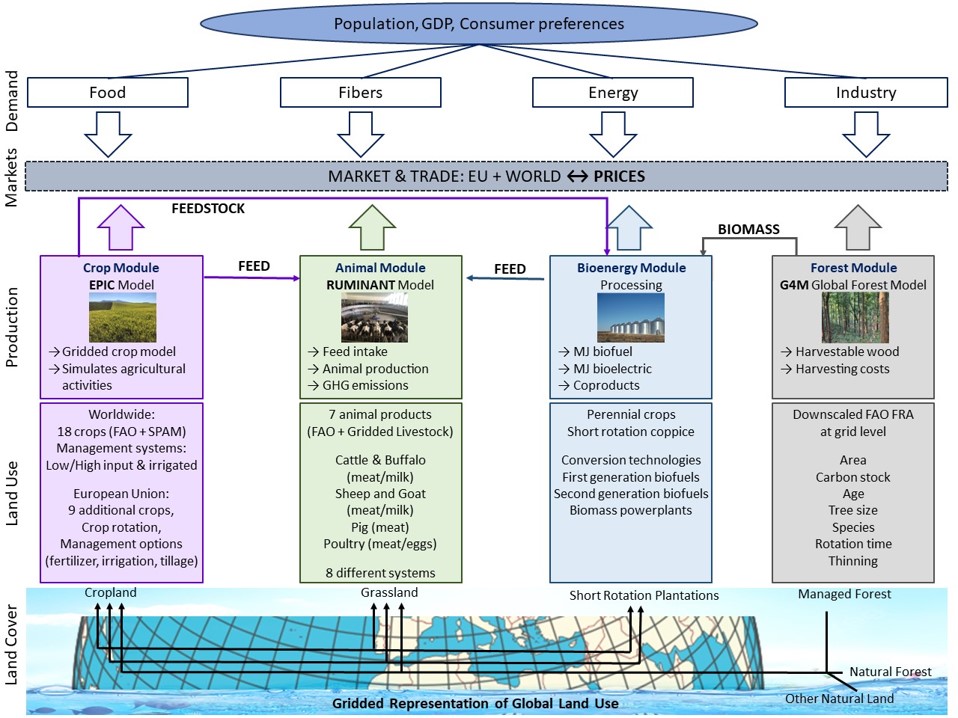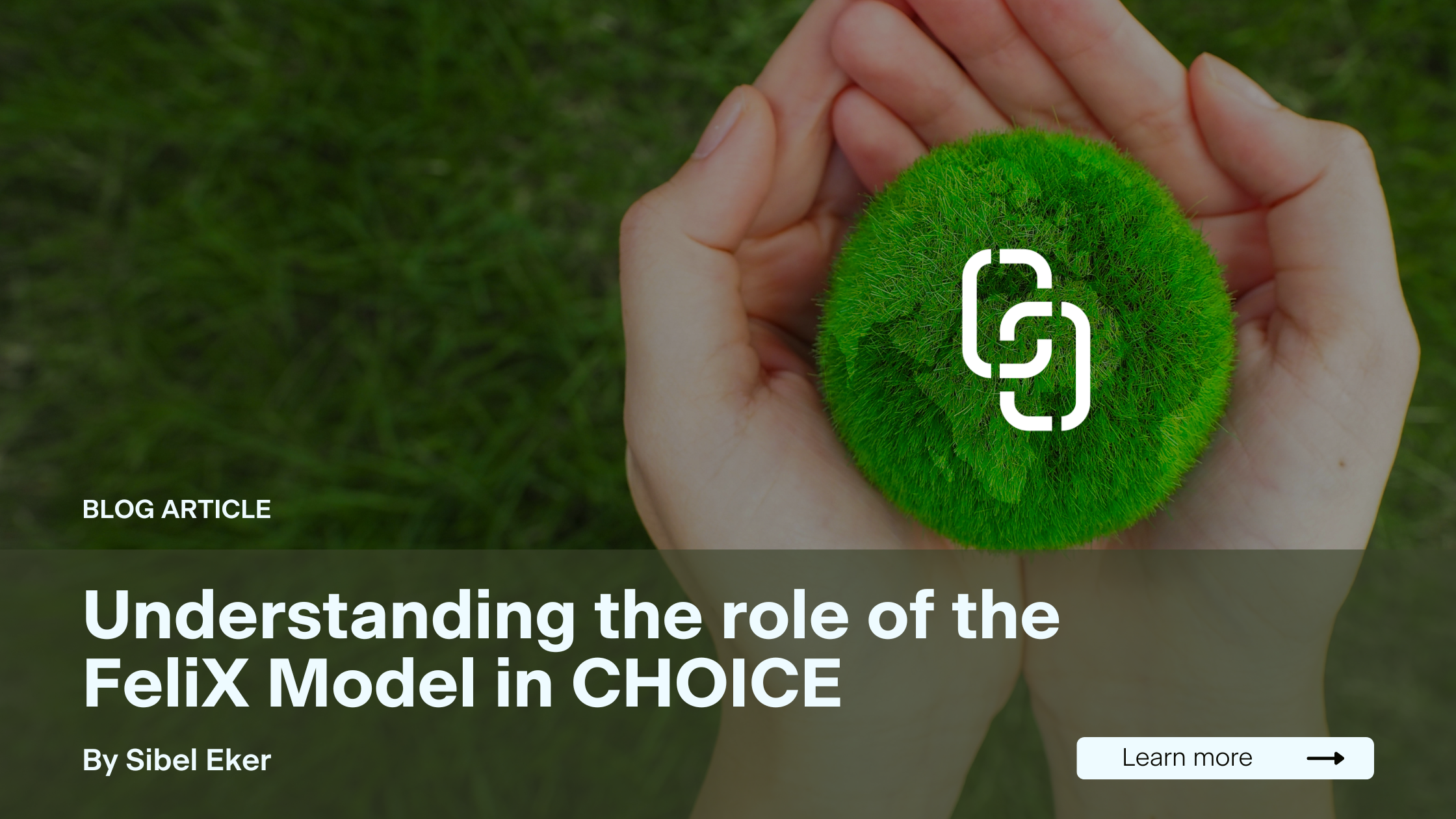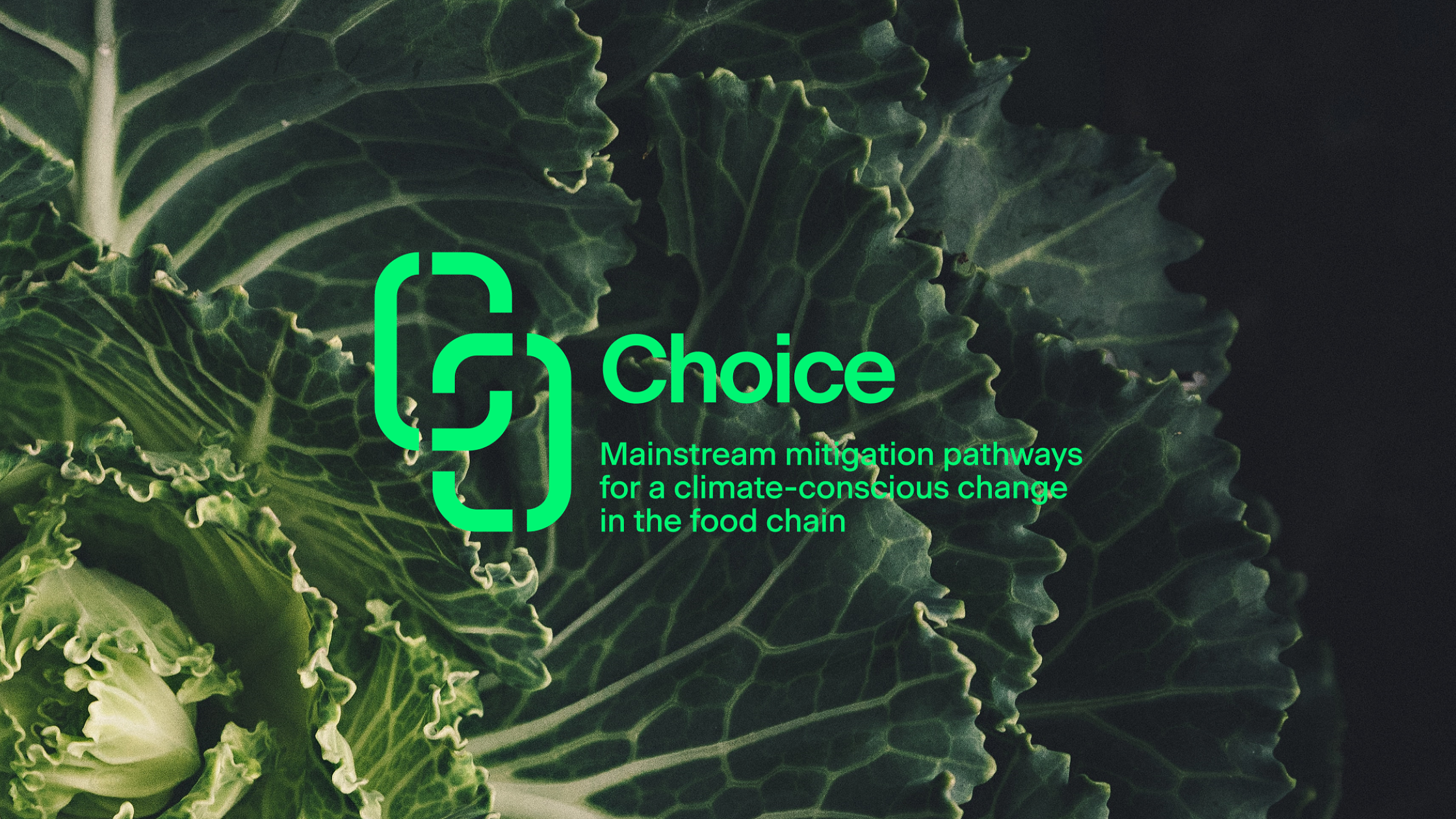
Understanding the GLOBIOM model in CHOICE
Introduction
The Global Biosphere Management Model, or GLOBIOM, plays a crucial role in the CHOICE project by helping us understand how land is used across the globe. As one of two Integrated Assessment Models in CHOICE, GLOBIOM focuses on the land use sector, offering insights into topics like deforestation, climate change, bioenergy, and agriculture.
In essence, GLOBIOM captures the complex connections between various systems that influence how we produce and consume agricultural and forestry products. It takes into account factors like population growth, shifts in economic and technological conditions, and changes in ecosystems and climate.
These factors drive changes in what we produce, how we use our land, and how we manage other valuable resources. GLOBIOM also shows us how different land uses are connected—like how farming impacts forests or how bioenergy policies can affect food production. By exploring these connections, GLOBIOM helps policymakers make better decisions, balancing economic objectives with environmental protection.
What is GLOBIOM
GLOBIOM is a partial-equilibrium model representing the main land use sectors globally. This means that it simulates economic market equilibrium for the selected sectors: agriculture, forestry, and biofuels. GLOBIOM is a spatially explicit bottom-up model with detailed representation of land-use sectors including different production systems and mitigation technologies capturing food system dynamics and spillover effects across scales (spatially explicit to global) and sectors (Figure 1) . It accounts for the 18 most globally important crops, a range of livestock production activities, forestry commodities, first- and second-generation biofuels. The spatial resolution of the supply side relies on the concept of Simulation Units, which are aggregates of 5 to 30 arcmin pixels belonging to the same altitude, slope, and soil class, and follows country borders.
Figure 1. Schematic presentation of the GLOBIOM model
(source: (IBF-IIASA, 2023)
Commodity markets and international trade are modelled at the level of various aggregate economic regions where prices are endogenously determined at the regional level to establish market equilibrium. Food demand in GLOBIOM is endogenous and depends on population, gross domestic product (GDP), and own product price.
Population and GDP are exogenous variables, while prices are endogenous. Impacts of price and GDP changes on demand are determined by price and income elasticities respectively. These elasticities are specific for each product and each region. Trade is modelled following the spatial equilibrium approach based on cost competitiveness and homogeneous good assumption that allows for tracing of bilateral trade flows between individual regions.
This detailed structure allows for a rich set of environmental and socio-economic parameters, such as prevalence of under-nourishment, deforestation, water withdrawals, nitrogen fertilizer use, GHG emissions, to be taken into account. It also captures spillovers and indirect land use change effects mediated through market interactions.
GLOBIOM is a key land-use and food system model used in various Integrated Assessment Models (IAMs) to assess the land-use related impacts on climate change, biodiversity, and the natural environment.
GLOBIOM serves as a land-use and food system model in many IAMs, such as MESSAGEix, POLES, POTENCIA, PRIMES, and WITCH and plays a key role in understanding land use dynamics and their impact on climate change, biodiversity and other environmental indicators. The model is currently used by policy makers, including the European Commission, to assess land-use related impacts of for example Energy and Climate Policies.
How GLOBIOM is used in CHOICE
In the CHOICE project, GLOBIOM is getting a major upgrade. The model will now be able to reflect the diverse needs and behaviors of different groups of people, considering factors like age, gender, and education. This is a big step forward because it allows us to see how different consumer groups might respond to changes in food and climate policies. For example, how might dietary shifts or food waste reduction initiatives impact not just the environment but also public health? By capturing this level of detail, GLOBIOM will help create policies that are not only effective but also fair and tailored to the needs of different communities.
Another exciting development is the model’s improved ability to trace the entire journey of food—from how it’s grown, to how it’s traded, all the way to its impact on local environments and global markets. This enhanced version of GLOBIOM will be crucial for assessing the EU’s transition toward climate-neutral food systems, ensuring that our efforts to combat climate change don’t come at the expense of food security or public health.


Real-World Applications and Benefits
GLOBIOM has already been used in a variety of ways to help policymakers navigate the complex landscape of land use and climate change. Here are a few examples:
- Food Security and Climate Change: GLOBIOM has been used to assess how climate change and ambitious climate policies might impact global food security, helping to ensure that efforts to reduce greenhouse gas emissions don’t lead to food shortages(Frank et al., 2017; Fujimori et al., 2022; Hasegawa et al., 2018).
- Biodiversity: The model has contributed to major reports on biodiversity, providing insights into how we can meet ambitious biodiversity goals while also addressing other environmental challenges(Leclère et al., 2020). It was featured in WWF’s Living Planet Report, IPBES’ Global Assessment Report, and UN-CBD’s Global Biodiversity Outlook 5.
- Impacts of Diets: GLOBIOM has been utilized to study how different diets affect food systems, climate change, biodiversity, and food security. This helps in understanding how dietary shifts can contribute to more sustainable and healthy food systems(De Vos et al., 2024; Kozicka et al., 2023).
- EU Climate Policies: GLOBIOM has been instrumental in shaping EU policies related to land use and climate change, helping the EU Commission develop strategies to meet its climate targets(Frank et al., 2016). This modeling framework has been applied for several assessments for the EU Commission, such as the EU Reference Scenarios, EU Long term Strategy, review of the ambition to 55%, and several legislative proposals of the Fit for 55 package.
- Biofuels: The model has also been used to study the impact of biofuel policies on land use and greenhouse gas emissions, ensuring that biofuels contribute to climate goals without harming food production or forests(Seber et al., 2022; Valin et al., 2015).

Conclusion
GLOBIOM is a powerful tool that helps us understand the global land use sector, from agriculture and forestry to bioenergy. Through the CHOICE project, GLOBIOM is being enhanced to better reflect the diverse ways people interact with food systems, leading to smarter, more inclusive policies. By improving our understanding of land use dynamics, GLOBIOM supports more effective strategies to combat climate change, protect biodiversity, and ensure food security for all.
Learn more!
To find out more, read the online model documentation and visit globiom.org
References
- De Vos, K., Janssens, C., Jacobs, L., Campforts, B., Boere, E., Kozicka, M., Leclère, D., Havlík, P., Hemerijckx, L. M., Van Rompaey, A., Maertens, M., & Govers, G. (2024). African food system and biodiversity mainly affected by urbanization via dietary shifts. Nature Sustainability, 1–10. https://doi.org/10.1038/s41893-024-01362-2
- Frank, S., Beach, R., Havlík, P., Valin, H., Herrero, M., Mosnier, A., Hasegawa, T., Creason, J., Ragnauth, S., & Obersteiner, M. (2018). Structural change as a key component for agricultural non-CO2 mitigation efforts. Nature Communications, 9(1). https://doi.org/10.1038/S41467-018-03489-1
- Frank, S., Havlík, P., Soussana, J. F., Levesque, A., Valin, H., Wollenberg, E., Kleinwechter, U., Fricko, O., Gusti, M., Herrero, M., Smith, P., Hasegawa, T., Kraxner, F., & Obersteiner, M. (2017). Reducing greenhouse gas emissions in agriculture without compromising food security? Environmental Research Letters, 12(10), 105004. https://doi.org/10.1088/1748-9326/AA8C83
- Fujimori, S., Wu, W., Doelman, J., Frank, S., Hristov, J., Kyle, P., Sands, R., van Zeist, W. J., Havlik, P., Domínguez, I. P., Sahoo, A., Stehfest, E., Tabeau, A., Valin, H., van Meijl, H., Hasegawa, T., & Takahashi, K. (2022). Land-based climate change mitigation measures can affect agricultural markets and food security. Nature Food, 3(2), 110–121. https://doi.org/10.1038/s43016-022-00464-4
- Hasegawa, T., Fujimori, S., Havlík, P., Valin, H., Bodirsky, B. L., Doelman, J. C., Fellmann, T., Kyle, P., Koopman, J. F. L., Lotze-Campen, H., Mason-D’Croz, D., Ochi, Y., Pérez Domínguez, I., Stehfest, E., Sulser, T. B., Tabeau, A., Takahashi, K., Takakura, J., van Meijl, H., … Witzke, P. (2018). Risk of increased food insecurity under stringent global climate change mitigation policy. Nature Climate Change, 8(8), 699–703. https://doi.org/10.1038/s41558-018-0230-x
- Kozicka, M., Havlík, P., Valin, H., Wollenberg, E., Deppermann, A., Leclère, D., Lauri, P., Moses, R., Boere, E., Frank, S., Davis, C., Park, E., & Gurwick, N. (2023). Feeding climate and biodiversity goals with novel plant-based meat and milk alternatives. Nature Communications, 14(1). https://doi.org/10.1038/S41467-023-40899-2
- Leclère, D., Obersteiner, M., Barrett, M., Butchart, S. H. M., Chaudhary, A., De Palma, A., DeClerck, F. A. J., Di Marco, M., Doelman, J. C., Dürauer, M., Freeman, R., Harfoot, M., Hasegawa, T., Hellweg, S., Hilbers, J. P., Hill, S. L. L., Humpenöder, F., Jennings, N., Krisztin, T., … Young, L. (2020). Bending the curve of terrestrial biodiversity needs an integrated strategy. Nature, 585(7826), 551–556. https://doi.org/10.1038/s41586-020-2705-y
- Seber, G., Escobar, N., Valin, H., & Malina, R. (2022). Uncertainty in life cycle greenhouse gas emissions of sustainable aviation fuels from vegetable oils. Renewable and Sustainable Energy Reviews, 170, 112945. https://doi.org/10.1016/J.RSER.2022.112945
- Valin, H., Peters, D., van den Berg, M., & Frank, S. (2015). The land use change impact of biofuels in the EU: Quantification of area and greenhouse gas impacts. https://ec.europa.eu/energy/sites/ener/files/documents/Final Report_GLOBIOM_publication.pdf | Final Report_GLOBIOM_publication.pdf (iiasa.ac.at)





